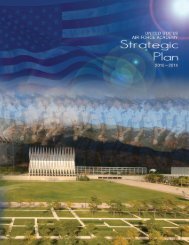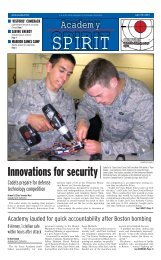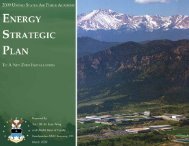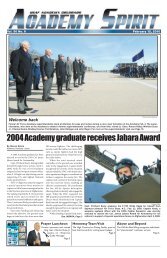2008-2009 Catalog - United States Air Force Academy
2008-2009 Catalog - United States Air Force Academy
2008-2009 Catalog - United States Air Force Academy
You also want an ePaper? Increase the reach of your titles
YUMPU automatically turns print PDFs into web optimized ePapers that Google loves.
meteorology major<br />
Meteorology is the study of atmospheric phenomena. The Meteorology major provides the background necessary for<br />
understanding atmospheric behavior over a broad range of time and space scales. These include small features such as<br />
turbulent eddies and tornadoes; medium-sized features such as squall lines, hurricanes, and blizzards; and even larger features<br />
such as continental weather, climate regimes and waves in the jet stream.<br />
The science of meteorology has experienced dramatic changes. New observation techniques based on remote sensing have<br />
improved our understanding of weather phenomena and their interrelationships. Images of the earth from satellites have<br />
given us a truly global weather perspective. Doppler radar enables us to look at the circulations within thunderstorms to try<br />
to identify whether they might generate a tornado. Coupled with this increased observational capability, the introduction of<br />
sophisticated numerical weather prediction models has greatly improved our ability to forecast the weather.<br />
The Meteorology major requires a strong foundation in physics, geospatial science, and mathematics, in addition to an aptitude<br />
for problem solving. Many of the decisions <strong>Air</strong> <strong>Force</strong> officers make, from planning deployments and air strikes in a time of war<br />
to launching the Space Shuttle, flying a sortie, or simply deciding what uniform to wear on a particular day, are affected by the<br />
weather. While graduates in the Meteorology major are academically qualified to enter the weather career field, future pilots<br />
and navigators can greatly benefit from a better understanding of the environment in which they fly.<br />
Suggested Course Sequence<br />
3rd-Class Year 2nd-Class Year 1st-Class Year<br />
Biology 315 Aero Engr 315 <strong>Academy</strong> Opt<br />
Chem 200 Beh Sci 310 Astro Engr 410<br />
Econ 201 El Engr 315 English 411<br />
English 211 History 302 Meteor 431<br />
Engr Mech 220 Math 300/356/377 Meteor 440<br />
Law 220 Meteor 325 Meteor 451<br />
Math 243 Meteor 330 Meteor 452<br />
Math 245 Meteor 352 Meteor 465<br />
Meteor 320 Meteor 430 Meteor 490<br />
MSS 200 Philos 310 Mgt 400<br />
Physics 215 Physics 370 MSS 400<br />
Pol Sci 211 Sys Opt Geo 310 Soc Sci 412<br />
METEOROLOGY (Meteor)<br />
Offered by the Departments of Economics and Geosciences and Physics.<br />
Meteor 320. Introduction to Meteorology and Aviation Weather. Surveys the fundamentals of meteorology. Emphasizes<br />
flight weather and its impact on aviation. Topics include atmospheric thermodynamics, cloud physics, air masses and<br />
weather systems, weather forecasting, severe weather, hazards to aviation, introduction to weather satellites and radar, and an<br />
introduction to the near-earth space environment.<br />
Meteor 325. Weather Data, Analysis and Quantitative Methods. Introduction to the data sources, objective and subjective<br />
data analysis techniques, and quantitative methods used in meteorology. Topics include conventional surface and upper<br />
air data, fundamentals of radar and satellite observations, weather map analysis, and quantitative methods covering partial<br />
derivatives, vector analysis, kinematic properties of fluid flow, Lagrangian and Eulerian frames of reference, and numerical<br />
integration and differentiation. Emphasizes practical application of the above quantitative techniques to weather charts and<br />
vertical atmospheric soundings.<br />
Meteor 330. Atmospheric Physics. Classical radiative transfer, thermodynamics and microphysics applied to the<br />
atmosphere. Topics include atmospheric absorption and attenuation, the gas laws, the first and second laws of thermodynamics,<br />
water-air systems, isobaric, adiabatic and isentropic processes, thermodynamic diagrams, atmospheric statics and vertical<br />
stability, atmospheric aerosols, nucleation of water vapor and ice, cloud droplet and ice crystal growth, and precipitation<br />
generation.<br />
128 <strong>United</strong> <strong>States</strong> <strong>Air</strong> <strong>Force</strong> <strong>Academy</strong> <strong>Catalog</strong>
















